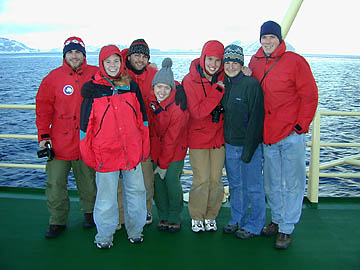
Mother's Day - Drake Passage

Happy Mother's Day from the Hamilton students aboard the Nathaniel B. Palmer!
It's 1 am Sunday. Seas are calm, winds light, temperature at 32 F and it's snowing. A few icebergs are around, showing up on the bridge radar. We have left the Drake Passage, passed the northeastern end of King George Island in the South Shetland Island chain and are heading for the Antarctic Sound. As we pass through the sound we will turn south and enter the Prince Gustav Channel which lies between the Antarctic Peninsula and James Ross Island. Scenery should be spectacular. Peaks along the this part of the Peninsula are 4-5000 feet high, rising directly from the sea.
The head of the Price Gustav marks the point where we will begin our work. The first item on the agenda is seismic profiling of the channel. This work will be carried out by the Italian members of our team. Seismic surveys are carried out by reflecting sound waves off the ocean floor and then recording strength and the time it takes for the wave to return. These waves are designed to penetrate the sediments, possibly all the way to the underlying bedrock, revealing the depth of sediments that have accumulated in the area.
The equipment used to accomplish this consists of an "air gun" to generated the energy waves, hydrophones to record the reflected waves, and about 10 feet of counter space filled with computers and printers to analyze and print the data. The air gun generates the sound waves by releasing a bubbles of ompressed air under the water at specific intervals. Just like blowing bubbles in a drink with a straw. These bubbles need to have a constant size, shape and volume in order to generate equal sound waves. One of early problems with this technology was that the bubbles tended to undulate so the energy released was not consistent.
The air gun we have on board solves this problem by injecting a small amount of additional air into the formed bubble to damp out the bubbles oscillation producing consistent bubbles.
The calmer seas have brought relief to those who were not feeling well during the crossing and everyone is anxious to get to work.
Current Lat/Long 62 49 S, 57 03 W
More to come, Cheers,
Dave Tewksbury
tewksbda@nbp.polar.org